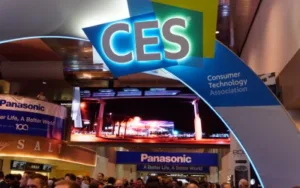Because of its position in the calendar, the CES show in Las Vegas is always the most important for TV technology. While IFA is also an interesting show, at that show in September, the event is also a place where orders are placed or decided for the critical Q4 sales season, so it is never quite as interesting. It’s also open to the public, so brands don’t want to give them a reason to defer a purchase. By CES, the peak of the TV buying season in the West is over and its the start of a new cycle. New models will be shown to channel partners in the spring and rolled out in Q2 and Q3.
This year, there were a lot of interesting developments. The story of 2017 was the success of LG’s OLED technology in the high end of the TV market, and we forecast that Samsung would be back aggressively to compete and from the demonstrations that we report on here, they have come back with a bang. Personally, my own view on the Samsung Wall is that it is an interesting COB LED and has a great image, but its revelation at CES, rather than ISE, where the firm might actually find customers, was mainly a publicity stunt. However, it does show the long term potential of LED to those that haven’t been following developments in LED as closely as we, and our regular readers, have.
 CES was busy. Image:Meko
CES was busy. Image:Meko
What really impressed me was the improvement in Samsung’s LCD TVs, which will be announced in a new range in a couple of months. They looked really good in the private ‘Innovation Zone’ and that highlighted that while LG’s OLEDs continued to look great, the panels to be used in 2018 will be similar to those in 2017 sets. That suggests to us that LG Display has hit a roadblock in terms of OLED performance, which is not a real surprise as there haven’t been any real breakthroughs in materials, despite the promise of TAFD materials in 2017.
Nanosys was privately showing new QD architectures that should allow LCD TVs to continue to improve in viewing angle, brightness and colour and the Nvidia BFDG really showed how speed issues have been pretty well overcome. Sony showed that LCD can be pushed to amazing levels of output with its 10,000 cd/m².
In 2018, LCDs will really come back to compete with OLED.
On the other hand, LG Display, with its 8K OLED and especially the rollable OLED, really set out how the market could develop, perhaps as early as 2019 as LGD does not usually show products like this unless it has a roadmap to production, although that is only our ‘informed speculation’.
Beyond the visual, there was a big emphasis on voice control and using the TV as the home hub for IoT applications. That was part of a huge push around voice in cars, household appliances and almost everywhere else. We didn’t get quite as much coverage on SoCs for TVs as we hoped, but from what we did see, there is a lot of potential with the latest generation.
Audio for TV saw a big boost and there is widening support for Adobe Atmos in TVs. We went to an impressive demo by Realtek of Atmos being rendered on a simple pair of cheap speakers that shows the potential for audio improvement. Samsung had some interesting technology for audio level control and LGD showed a boost from two to three channels with its direct audio from OLED surfaces. eArc is a topic we have been talking about and this year the technology should get into some TVs to solve some problems in home AV system assembly.
There were a number of Laser-phosphor UST projection TVs and they looked good, but not as good as the best flat panels, because of the limits in dynamic range. That’s a big change compared to some years ago, when the LCD TVs looked very poor compared to the best projectors. That’s not good news for the home cinema business, but the projector companies can see this and there has been a big change in the relative price of UltraHD and laser phosphor projectors.
In the end, tough competition seen in TVs at CES is really strong argument for the benefits of this competition, for consumers at least! – Bob Raikes
(Note that this is part 1 of our CES report. The second part will cover the non-TV topics)

